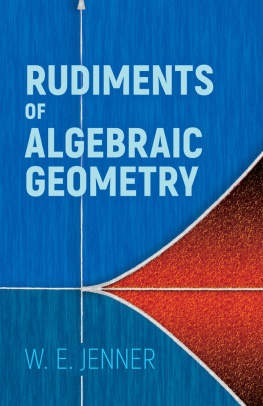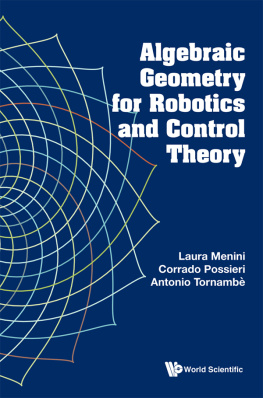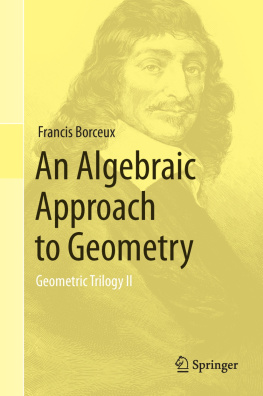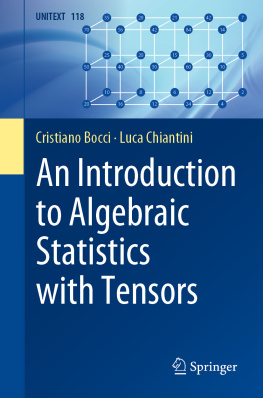Bibliographical Note
This Dover edition, first published in 2018, is an unabridged republication of the work originally published in 1963 by Oxford University Press, New York.
Library of Congress Cataloging-in-Publication Data
Names: Jenner, William Elliott, 1924- author.
Title: Rudiments of algebraic geometry / W.E. Jenner.
Description: Dover edition. | Mineola, New York : Dover Publications, Inc.,
2018. | Originally published: New York : Oxford University Press, 1963. | Includes bibliographical references.
Identifiers: LCCN 2017029716 | ISBN 9780486818061 | ISBN 0486818063
Subjects: LCSH: Geometry, Algebraic.
Classification: LCC QA564 .J4 2018 | DDC 516-dc23
LC record available at https://lccn.loc.gov/2017029716
Manufactured in the United States by LSC Communications
81806301 2017
www.doverpublications.com
CONTENTS
INTRODUCTION
One of the most significant developments in recent mathematics is the resurgence of interest in algebraic geometry, a trend dating more or less from the publication of Weils Foundations. Up to the present time, this revival has manifested itself only at the graduate level and beyond. At the undergraduate level on the other hand, the geometric traditions, if represented at all, usually have been presented in the form of a course in analytic or synthetic projective geometry, culminating in the theory of the conic sections. The transition from this to modern algebraic geometry is beset with imposing obstacles, as most people who have gone through the experience will testify. As matters stand at present, to exaggerate only slightly, students have virtually no geometric experience of much significance between their freshman study of conics and quadrics and some graduate course devoted, more likely than not, to proving the Riemann-Roch Theorem in six easy lessons using sheaves and this sometimes without having ever beheld a curve possessed of a singular point. One purpose of this book is to assist graduate students who find themselves in this position and to obviate for them, at least partially, the necessity of struggling with the confusion, obscurity, and downright error which sometimes arise as one extracts the needed information from some of the older literature.
Nevertheless, the book is addressed primarily to undergraduates and is intended to supplement, or to provide an alternative to, more traditional subject matter. In this way it is hoped to suggest some idea of the actual concerns of present-day geometers, and at the same time to make the .
There is perhaps a legitimate question, particularly among the experts, as to whether it is desirable or indeed possibleto say anything worthwhile about algebraic geometry at the undergraduate level. My own answer is in the affirmative and this book represents the results of my attempt to deal with the question. In view of the absence of precedents, it is difficult to be convinced that one has chosen the right things to talk about. The choices made here are admittedly tentative, and it is hoped that further experimentation by others, more competent than myself, will lead to a more definitive result.
From a technical point of view, the principal aim of the book is to close part of the gap between elementary analytic geometry and abstract algebraic geometry along the lines, for instance, of Langs recent book the rather strong initial algebraic assumptions that are usually made in abstract algebraic geometry.
A few words may clarify the point of view taken on certain topics. First of all, points are defined as n-tuples not even as equivalence classes under certain admissible transformations. This is quite sufficient for the purpose at hand, and bases the theory on a very simple set-theoretical construction rather than on the invention of a new class of things called points which are apt to evoke nonsensical metaphysical questions. One consequence of the point of view adopted here is that a transformation always appears as something that moves points around, and not as something that changes co-ordinates. It is, of course, important to understand the two ways of looking at these things. Usually, however, this is carefully dealt with in courses in linear algebra and it is unnecessary to discuss it here.
Most of what goes on in this book is done over arbitrary fields. This is the only real divergence from current practice in algebraic geometry where it is customary to work over a so-called universal domain.









